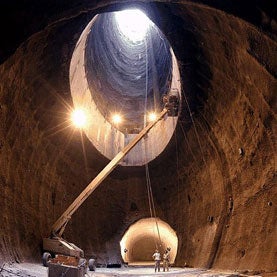
Known as the Circular Electron–Positron Collider, it is being developed at Beijing’s Institute of High Energy Physics.ĬERN’s current facility, the LHC, currently the world’s largest, is a looped tunnel running 100 metres beneath the Franco-Swiss border, near Geneva. Meanwhile, a Chinese plan, like CERN’s, foresees a 100 kilometre tunnel built over the next decade. That could play into a potential choice by European countries about whether to back the FCC, foreseen to run in the late 2050s. The Japanese government is expected to take a decision on whether it wants to host – and stump up cash for – a linear collider by March 7. The proposal, one of several that scientists and government delegates from CERN member countries will debate in the coming years, sees the lab in an international race to host the LHC’s successor, with China and Japan mulling rival facilities. The European particle physics research centre is proposing a €21 billion, 100 kilometre (62 mile) accelerator, given the working name of Future Circular Collider (FCC). With the shutdown of some of the other accelerators, CERN could thus lower its power use by 25%.CERN has unveiled bold plans for the largest particle accelerator ever – almost four times longer and ten times more powerful than its 27 kilometre (5 mile) Large Hadron Collider (LHC). The organization will shut down other accelerators first, before possibly having to resort to a shutdown of the world’s largest particle accelerator, he added. “Our concern is really grid stability, because we do all we can to prevent a blackout in our region,” Claudet told the Journal.ĬERN and its power supplier, EDF, are now discussing the possibility of implementing daily warnings for power grid instability at the research complex to determine when it would need to conserve energy and use less electricity, the head of CERN energy management panel told the WSJ. However, due to the energy crisis, CERN is now considering how it could idle the world’s most powerful collider. The collider was just restarted this July after a three-and-a-half-year hiatus for upgrades. May to mid-December is the period of active work at the Large Hadron Collider, the world’s largest and most powerful particle accelerator, which discovered ten years ago the existence of the Higgs boson that gives mass to the elementary particles. At peak consumption, usually from May to mid-December, CERN uses about 200 MW, which is about a third of the amount of energy used to feed the nearby city of Geneva in Switzerland.

That’s enough power to fuel 300,000 UK homes for a year. One of EDF’s largest clients is none other than CERN, which uses 1.3 terawatt hours of electricity annually. Currently, more than half of EDF’s reactors are out of operation either because of maintenance or technical issues. EDF will restart all its nuclear reactors in the country this winter, French Energy Transition Minister Agnès Pannier-Runacher said last week. French power prices have now soared tenfold over the past year, as drought and hot weather this summer have added to France’s nuclear power generation problems at the worst possible moment.


In France, year-ahead power prices surged to $1,001 (1,000 euro) per megawatt-hour for the first time ever last month. Large European industrial companies have already announced plant or production line closures due to soaring gas and energy prices, while governments in Europe are drafting plans to potentially ration gas supply to industries according to their specific priorities. The European Organization for Nuclear Research, CERN, the world’s largest particle physics lab and home of the Large Hadron Collider, could shut down some accelerators and could even idle the LHC to ensure grid stability in the nearby French and Swiss regions amid the severe energy crisis in Europe, Serge Claudet, chair of the CERN energy management panel, told The Wall Street Journal.Įurope is experiencing an unprecedented energy crisis amid halted Russian gas supply via the Nord Stream pipeline, low nuclear power generation in France, a power crisis in Switzerland, and sky-high gas and power prices. The energy crisis in Europe is not only disrupting businesses and household finances, but it’s also hitting at the heart of crucial scientific research and experiments.


 0 kommentar(er)
0 kommentar(er)
